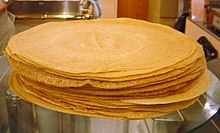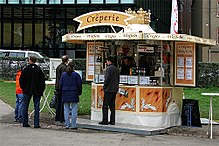Crêpe: Difference between revisions
→In other countries: rearranged, removed sopes |
Winnjewett (talk | contribs) Corrected English Pronunciation |
||
| Line 3: | Line 3: | ||
[[Image:Crêpe opened up.jpg|thumb|A sweet crêpe opened up, with [[whipped cream]] and [[strawberry]] [[sauce]] on it]] |
[[Image:Crêpe opened up.jpg|thumb|A sweet crêpe opened up, with [[whipped cream]] and [[strawberry]] [[sauce]] on it]] |
||
A '''crêpe''' ({{IPA-en| |
A '''crêpe''' ({{IPA-en|ˈkrɛp}}, {{IPA-fr|kʁɛp|lang}}) is a type of very thin [[pancake]], usually made from [[wheat flour]]. The word is of [[France|French]] origin, deriving from the [[Latin]] ''crispa'', meaning "curled." While crêpes originate from [[Brittany]], a region in the northwest of [[France]], their consumption is widespread in France and they are considered a national dish, and they are also increasingly popular in North America and South America. In Brittany, crêpes are traditionally served with [[cider]]. Crêpes are served with a variety of fillings, from the most simple with only sugar to [[flambé]]ed [[Crêpe Suzette|crêpes Suzette]] or elaborate savoury fillings. |
||
==Preparation== |
==Preparation== |
||
Revision as of 04:56, 2 January 2011


A crêpe (/ˈkrɛp/, French: [kʁɛp]) is a type of very thin pancake, usually made from wheat flour. The word is of French origin, deriving from the Latin crispa, meaning "curled." While crêpes originate from Brittany, a region in the northwest of France, their consumption is widespread in France and they are considered a national dish, and they are also increasingly popular in North America and South America. In Brittany, crêpes are traditionally served with cider. Crêpes are served with a variety of fillings, from the most simple with only sugar to flambéed crêpes Suzette or elaborate savoury fillings.
Preparation

Crêpes are made by pouring a thin liquid batter onto a hot frying pan or flat circular hot plate, often with a trace of butter on the pan's surface. The batter is spread evenly over the cooking surface of the pan or plate either by tilting the pan or by distributing the batter with an offset spatula. After the Crêpe has finished cooking it somewhat resembles a really thin pancake.
Common savoury fillings for crêpes include: cheese, asparagus, ham, spinach, eggs, ratatouille, mushrooms, artichoke (in certain regions), and various meat products.
When sweet, they can be eaten as dessert. They can be filled with various sweet toppings, often including Nutella spread, sugar (granulated or powdered), maple syrup, lemon juice, whipped cream, fruit spreads, custard, and sliced soft fruits or confiture.
Types and special crêpes
Crêpes are especially popular throughout France. The common ingredients include flour, eggs, milk, butter, and a pinch of salt. Crêpes are usually of two types: sweet crêpes (crêpes sucrées) made with wheat flour and slightly sweetened; and savoury galettes (crêpes salées) made with buckwheat flour and unsweetened. The name "galette" came from the word "galet", French for pebble, since the first gallettes were made on a large pebble heated in a fire. Batter made from buckwheat flour is gluten-free, which makes it possible for people who have a gluten allergy or intolerance to eat this type of crêpe.[citation needed]

Mille crêpe is a French cake made of many crêpe layers. "Mille" ("mil") means "a thousand", implying the many layers of crêpe.[1]

Another standard French and Belgian crêpe is the crêpe Suzette, a crêpe with lightly grated orange peel and liqueur (usually Grand Marnier) which is subsequently lit upon presentation.[citation needed]
It is also a fairly common practice to roll or envelop crêpes and then lightly fry, bake, or sautée them, not unlike blintz, whose preparation is similar.[citation needed]
Cherry Kijafa Crêpes are also often common and are made with a traditional crêpe base, but filled with cherries simmered in a Kijafa wine sauce.[2]
Some chefs insist that Beef Wellington should include a crêpe, wrapping the coated meat to retain moisture, thereby preventing the pastry from going soggy.[citation needed]
A common recipe practiced among bodybuilders is what is called a "Bodybuilder's Crêpe", traditionally made with whey protein powder, flavoring, egg white, and other healthy ingredients such as cottage cheese, oats, and peanut butter. They are prepared the same way as normal crêpes are, but can sometimes cook much faster.[clarification needed][citation needed]
Crêperies

A crêperie may be a takeaway restaurant or stall, serving crêpes as a form of fast food or street food, or may be a more formal sit-down restaurant or café.
Crêperies are typical of Brittany in France; however, crêperies can be found throughout France and in many other countries..
Because a crêpe may be served as both a main meal or a dessert, crêperies may be quite diverse in their selection and may offer other baked goods such as baguettes. They may also serve coffee, tea, buttermilk and cider (a popular drink to accompany crêpes).
In other countries
In Norwegian, it's called Pannekake, and in Dutch it's pannenkoeken. In Italy, crêpes are called crespella. In the Spanish regions of Galicia and Asturias they are traditionally served at carnivals. In Galicia they're called filloas, and may also be made with pork blood instead of milk. In Asturias they're called fayueles or frixuelos. In Turkey they are called "Akıtma". In Argentina they are called "panqueques" and are often eaten with dulce de leche (known in English as milk caramel).
In areas of Eastern Europe formerly belonging to the Austro-Hungarian empire, there is a thin pancake comparable to a crêpe that in Austro-Bavarian is called Palatschinken or Omletten; in Template:Lang-hu; and in Bosnian, Serbian, Bulgarian, Macedonian, Montenegrin, Czech, Croatian and Slovene and Template:Lang-bs; in Template:Lang-sk. In the Balkan region such as the countries of Albania, Bosnia, Croatia, Macedonia, Montenegro, and Serbia, palačinka or palaçinka may be eaten with fruit jam, quark cheese, sugar, honey, or the hazelnut-chocolate cream Nutella. In Ashkenazi Jewish cuisine, there is a similar dish known as the blintz.
The names for thin crêpes in other parts of Europe are:
Dishes with similar appearance, taste and preparation methods exist in other parts of the world as well. In India, a crepe made of fermented rice batter is called a dosa, which often has savory fillings. Another variety is called Patibola and is sweet in taste due to milk, jaggery or Sugar. The injara of Ehtiopian/Eritrean/Somali/Yemeni cuisine is often described as a thick crepe.
Crêpes in culture
In France, crêpes are traditionally served on Candlemas (La Chandeleur), February 2. This day was originally Virgin Mary's Blessing Day but became known as "avec Crêpe Day", referring to the tradition of offering crêpes. The belief was that if you could catch the crêpe with a frying pan after tossing it in the air with your left hand and holding a gold coin in your right hand, you would become rich that year.[3]
See also
References
This article includes a list of references, related reading, or external links, but its sources remain unclear because it lacks inline citations. (February 2008) |
- ^ Hesser, Amanda (2005-05-15). "The Way We Eat: Building a Modern, Multistoried Dessert". The New York Times.
- ^ Pancake House (2007). Crepes: Cherry Kijafa Crepes. Retrieved from http://www.originalpancakehouse.com/phm_crepes2.html.
- ^
Clay, Xanthe (2007-02-17). "With a flame in your art". London: Telegraph.co.uk. Retrieved 2008-04-25.
{{cite news}}: Unknown parameter|alturl=ignored (help)
